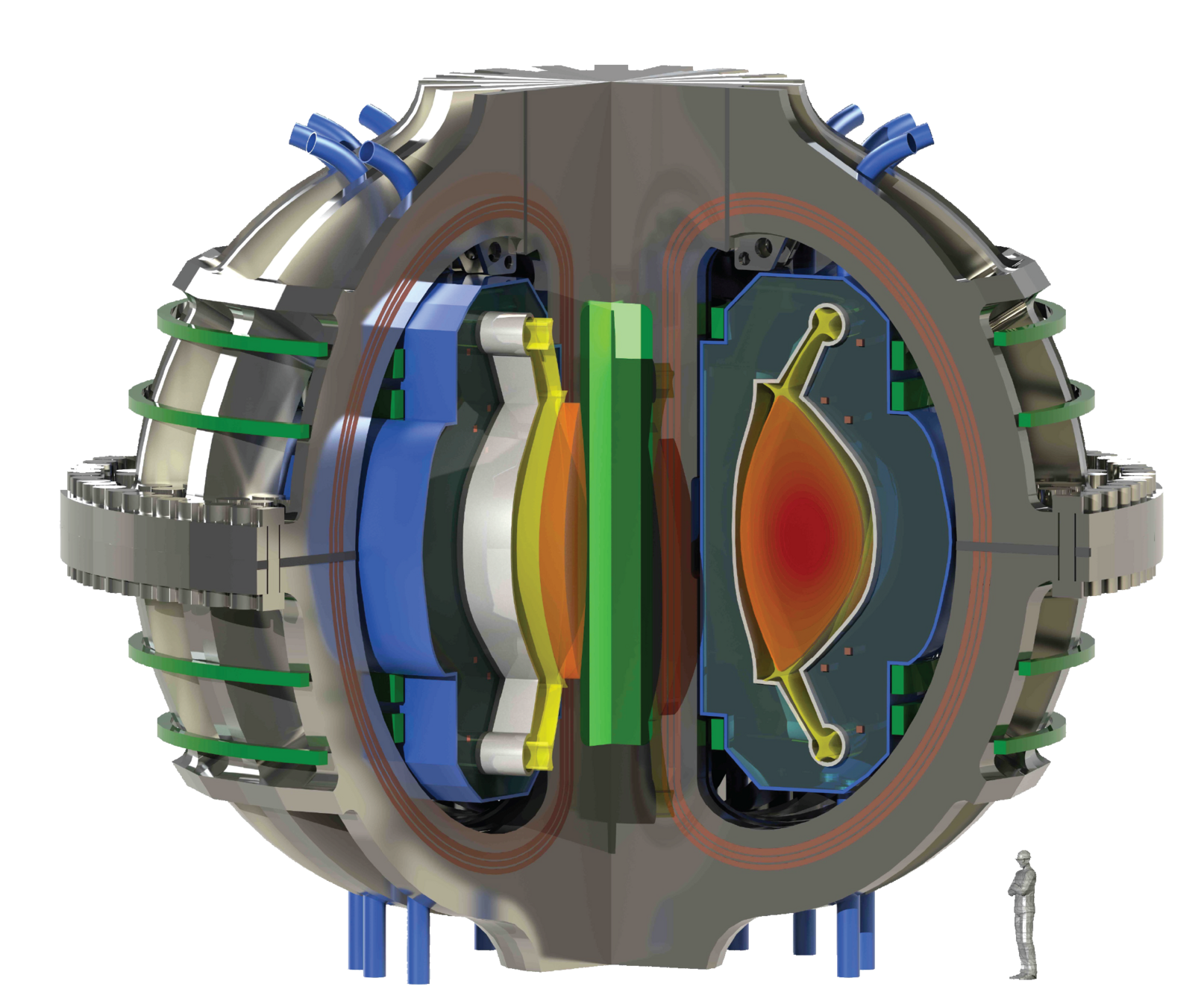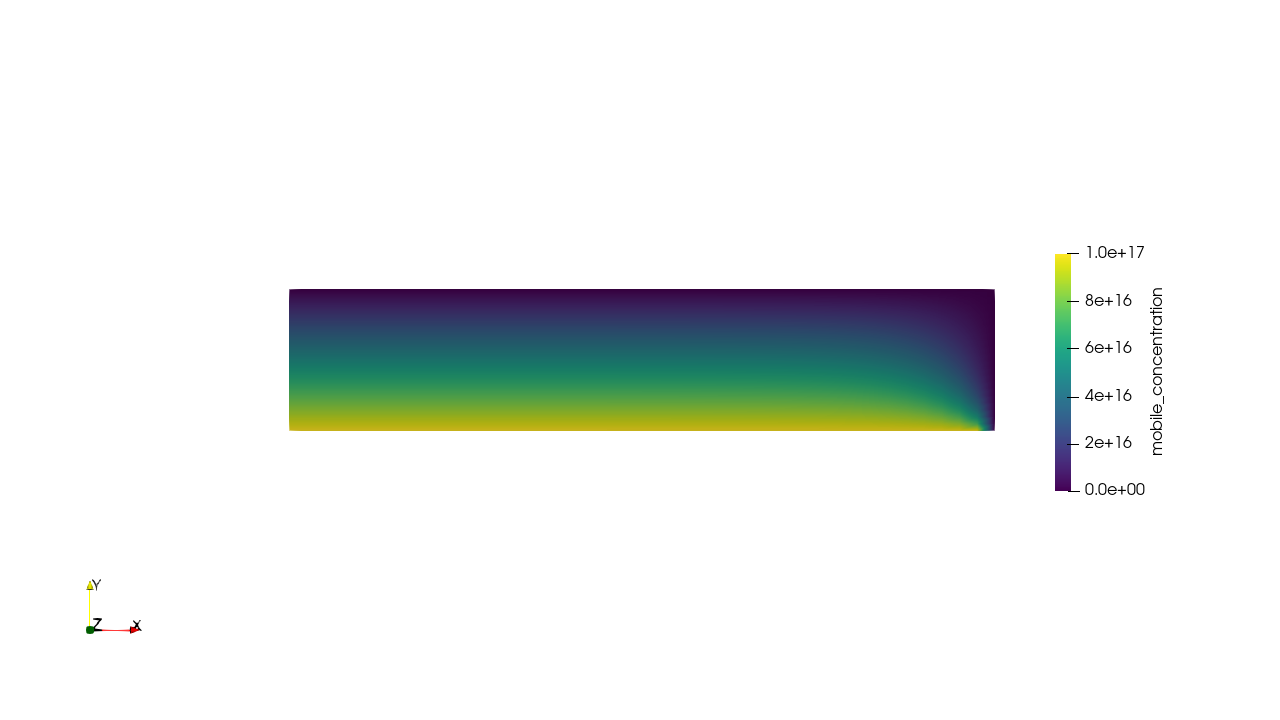FESTIM: overview of hydrogen transport simulation capabilities
Remi Delaporte-Mathurin and FESTIM contributors







User inputs
- Material properties
- Trap properties
- Geometry
- Boundary conditions
- Initial conditions
- ...
FESTIM
Outputs
- H concentration fields \(c(x,t)\)
- Temperature field \(T(x,t)\)
- surface fluxes
- inventories
- average concentration
- ...

Heat transfer model
Hydrogen transport model(s)
📈5 years of development
📑14+ publications
🗣️130+ citations
🧑💻23+ contributors
🏛️27+ institutions using the code
🧑💻80+ Slack members
⭐~100 stars on GitHub
🧑💻4 user workshops
FESTIM in numbers




✅100% open-source
Source code: github.com/festim-dev/FESTIM
Tutorials: github.com/festim-dev/FESTIM-workshop
Documentation: festim.readthedocs.io
FESTIM is verified & validated
-
Validated against TDS, permeation experiments...
-
Verified against analytical solutions in many different problems
- New V&V online book
festim-vv-report.readthedocs.io
- 19 V&V cases in total (more to come)
Remi Delaporte-Mathurin and Jair Santana, FESTIM V&V Book, 2024, https://dspace.mit.edu/handle/1721.1/156690.
FESTIM from mesoscale to reactor scale



Gas driven permeation

Surface limited regime
Bulk limited regime
Transition to bulk limited as the permeation number \( W \) increases
High H pressure
Low H pressure
Permeation flux

\( c = K_H \ P_\mathrm{up} \)
\( c = 0 \)
Permeation through the crucible wall
FLiBe
2D permeation through molten salts


HYPERION permeation rig
Permeation barriers

No barrier
with barrier
Permeation barrier
Substrate
High H pressure
Low H pressure
Permeation flux
Ongoing tritium permeation barriers development project at MIT
Conservation of chemical potential
TDS analysis: neutron damage

- New proposed model for neutron-induced trap creation
- Parameterised on TDS data (self-damaged W)
TDS analysis: neutron damage
- Model was used to simulate inventory evolution in PFCs
- Neglecting neutron traps could potentially underestimate inventories by several orders of magnitude after 1 FPY
- Need similar studies for structural materials!

TDS analysis: codeposits

- Simulation of W codeposited layers
- Influence of partial pressure
- 10 different traps!
Kinetic surface model

Kinetic surface model
V&V available at
github.com/KulaginVladimir/FESTIM-SurfaceKinetics-Validation
- D in damaged W (S. Markelj JNM 2016)
- Comparison with NRA profiles

Kinetic surface model
V&V available at
github.com/KulaginVladimir/FESTIM-SurfaceKinetics-Validation
- H in oxidised W (A. Dunand et al 2022 Nucl. Fusion)
- Comparison with TDS spectra

Kinetic surface model
V&V available at
github.com/KulaginVladimir/FESTIM-SurfaceKinetics-Validation
- H in Ti (Hirooka et al 1981 JNM)
- Validation at 5 temperatures

H content (H/Ti)
Component scale modelling & multiphysics
Influence of ELMs on retention

- 1D model of a ITER monoblock
- Transient heat transfer simulation
- Varying surface heat flux
Metal Foil Pumps for DIR

- H is implanted in the first \( 10 \ \mathrm{nm} \)
- Super-permeation regime is attained at high recombination energy (upstream surface)
- Source code

Benedikt & Day, (2017) Fusion Engineering and Design
Retention studies

- Delaporte-Mathurin et al 2024 International Journal of Hydrogen Energy 63 786–802
- Delaporte-Mathurin et al 2024 Nucl. Fusion 64 026003

- ITER plasma facing components
- Transient estimation of tritium retention
Retention (T/m3)
Detritiation studies


Breeding Blanket modelling



- DEMO WCLL
- Complex 3D geometry
- Coupled to fluid dynamics
- Tritium generation in the LiPb volume (computed from neutronics)
Tritium extraction system

- Permeation Against Vacuum
- Complex 3D geometry
- Coupled with fluid dynamics
- Tritium extraction from permeable membranes

MIT tritium breeding experiment

Velocity
Temperature
Tritium concentration
For more details on experiment: Delaporte-Mathurin et al, Advancing Tritium Self-Sufficiency in Fusion Power Plants: Insights from the BABY Experiment (under review in Nucl. Fusion)

① neutrons are generated
② tritium is created from nuclear reactions
③ tritium is transported in the salt
④ tritium is released into the gas phase
⑤ tritium is collected and counted
BABY breeding experiment
Towards FESTIM2
- Rewrite of FESTIM with FEniCSx
- Improved performances
- New physics and features
Spherical cavity trapping

see Zibrov and Schmid, NME, 2024
for complete description
- Implementation in FESTIM of the spherical cavity trapping model developed by Zibrov and Schmid
- Custom trapping equations
- Smooth implementation in FESTIM
Anisotropy
- Anisotropic materials can be simulated with very few modifications
- Composites
- Anisotropic microstructures



same underlying equations!
Can be represented by festim.Reaction
Isotope swapping
Trapping reactions
Swapping reaction
Isotope swapping


my_model.species = [
mobile_H,
mobile_D,
trapped_H,
trapped_D,
]
my_model.reactions = [
F.Reaction(
k_0=k_0,
E_k=0.39,
p_0=1e13,
E_p=1.2,
reactant1=mobile_H,
reactant2=empty_trap,
product=trapped_H,
volume=my_subdomain,
),
F.Reaction(
k_0=k_0,
E_k=0.39,
p_0=1e13,
E_p=1.2,
reactant1=mobile_D,
reactant2=empty_trap,
product=trapped_D,
volume=my_subdomain,
),
F.Reaction(
k_0=k_0,
E_k=0.1,
p_0=k_0,
E_p=0.1,
reactant1=mobile_H,
reactant2=trapped_D,
product=[mobile_D, trapped_H],
volume=my_subdomain,
),
]Usual trapping reactions
Swapping reaction
4 species are defined
Multi-isotope transport and multi-level trapping

- 2 isotopes, 1 trap (2 levels)
- 7 different species
- 6 reactions
✅Mixed domain can streamline multiphysics coupling
❌Some methods do not work for dissimilar materials (Henry vs Sieverts)
FESTIM 2 is much faster

3-30x
faster

HISP project: coupling FESTIM to plasma codes



RISP pulse
ITER FW divided in 60 bins
Data from DINA


Goal: find the best strategy for minimising ITER T inventory
HISP project: coupling FESTIM to plasma codes





10 DT FP pulses
ICWC + RISP
GDC
Simulation time:
~ 60 s per bin (~ hour full reactor)
HISP project: coupling FESTIM to plasma codes





- Multi isotopes
- Parametrisation for W, B, SS
- Testing different scenarios for detritiation in ITER
- Flexible enough to be reactor-and plasma code-agnostic
- Open-source development
github.com/kaelyndunnell/hisp
Take aways
🚀FESTIM is extremely versatile, from simple to complex cases, from small scale to large scale.
🔓FESTIM is accessible to everyone. FESTIM2 is already usable now and will soon be released as alpha
🫵We - the festim developers - want to work with you - potential users - to have it benefit your work.